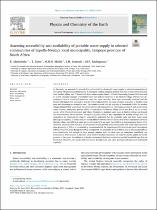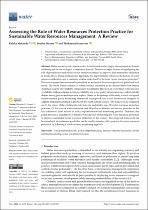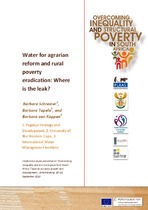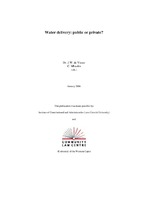| dc.contributor.author | T, Dube | |
| dc.contributor.author | K, Mashabela | |
| dc.contributor.author | M.H.N., Mollel | |
| dc.date.accessioned | 2022-06-29T13:04:48Z | |
| dc.date.available | 2022-06-29T13:04:48Z | |
| dc.date.issued | 2022 | |
| dc.identifier.citation | Mashabela, K., Dube, T., Mollel, M., Letsoalo, J. and Radingoana, M., 2022. Assessing accessibility and availability of portable water supply in selected communities of Lepelle-Nkumpi local municipality, Limpopo province of South Africa. Physics and Chemistry of the Earth, Parts A/B/C, 127, p.103181. | en_US |
| dc.identifier.uri | https://doi.org/10.1016/j.pce.2022.103181 | |
| dc.identifier.uri | http://hdl.handle.net/10566/7537 | |
| dc.description.abstract | In this study, we assessed the accessibility and availability of portable water supply in selected communities of the Lepelle-Nkumpi Local Municipality. A systematic random sampling method was used to select 49 households from Mashite village and 77 households from Lebowakgomo Zone F. A Global Positioning System (GPS) was used to collect absolute locations of available water taps and the reservoir in the Mashite village whereas for Lebowakgomo Zone F municipal household taps data were recorded. Data were statistically analysed and the
Pearson Chi-Square test was used to test the relationship between the reuse of onsite greywater at Mashite rural area and Lebowakgomo township area. The results showed that the majority of households (38%) in Mashite village obtained their water from the rivers whereas all respondents in Lebowakgomo Zone F had access to tap water. Further, ninety-four percent (94%) of respondents in Mashite village travel less than 1 km to a water source, while 6% travel between 1 and 3 kms. Proximity to standard water pipes in Mashite village was beyond
the recommended 200 m distance. Thirty-five percent (35%) of the respondents in Mashite village and 77% respondents in Lebowakgomo Zone F, respectively, indicated that the available water met their water needs although the quantity of water used per month differed between the two areas. Most of the respondents (56%) in Mashite village used 250 L of water per month while 61% use more than 6000 L in Lebowakgomo Zone F. It is, therefore, recommended that local municipalities should provide rural communities with water taps that are in
close proximity of 200 m to households as recommended by the Department of Provincial and Local Government (DPLG). However, even though the DPLG recommends the proximity level of 200 m, this is still questionable as some households still struggle to have enough running water as these taps are sometimes vandalised, not functional or even situated in elevated areas were it becomes impossible for water to ascend uphill due to the pressure of the water. In addition, it is further recommend that local authorities provide household taps that are functional. Moreover, the service delivery should be improved, and water provision infrastructure maintained regularly. | en_US |
| dc.publisher | elsevier | en_US |
| dc.subject | Rainwater harvesting | en_US |
| dc.subject | Water accessibility | en_US |
| dc.subject | Water management | en_US |
| dc.subject | Water reuse | en_US |
| dc.subject | Water scarcity | en_US |
| dc.title | Assessing accessibility and availability of portable water supply in selected communities of Lepelle-Nkumpi local municipality, Limpopo province of South Africa | en_US |
| dc.type | Article | en_US |




